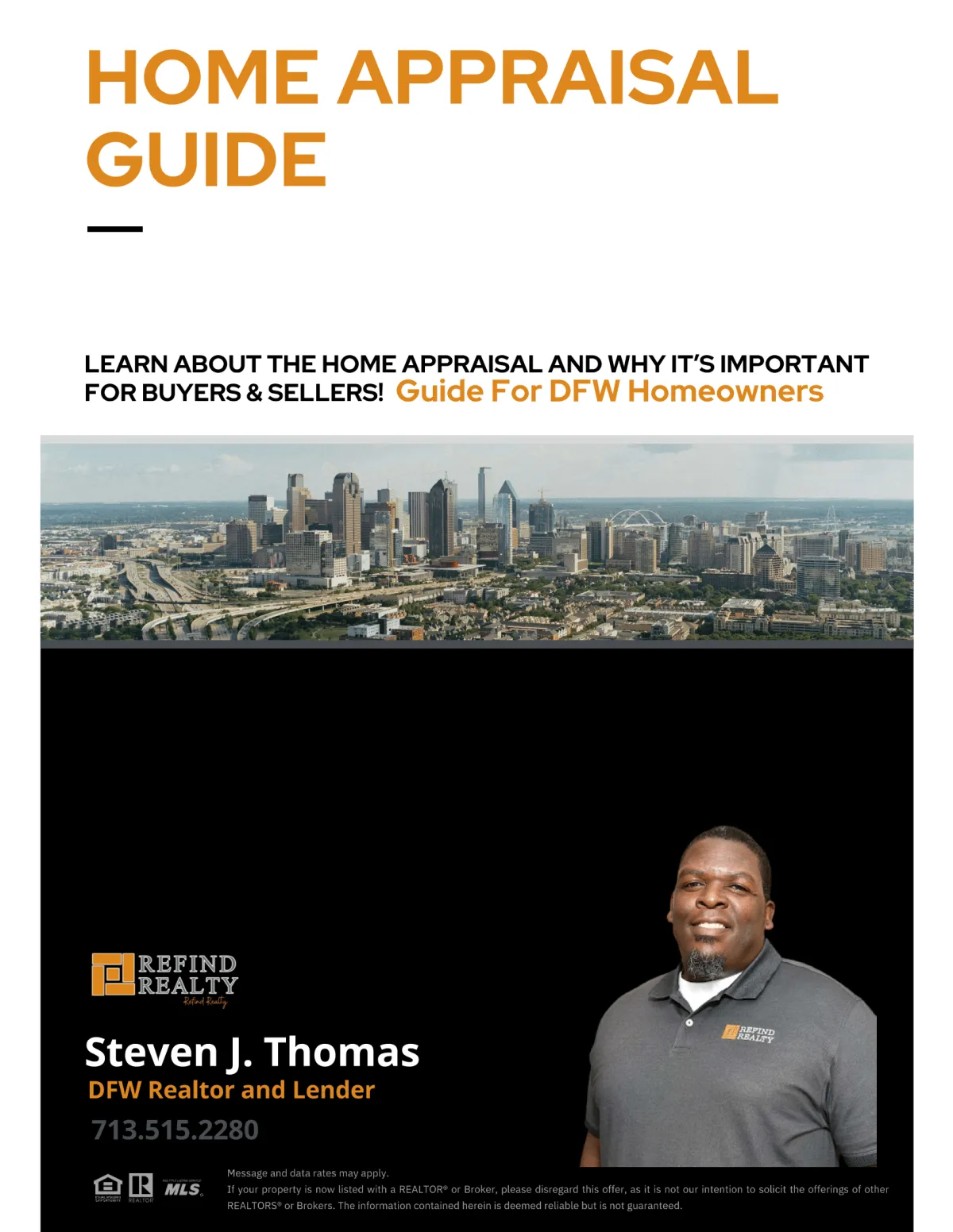You're Always At Home With Refind Realty.
Serving Your DFW Real Estate Needs Since 2005.
We Help You Buy and Sell in The Greater Dallas-Fort Worth Area.
Check Out Our Social Media Channels!
Buying in DFW
Buying your first or next home should be a rewarding and exciting time in your life, and one that you look back on with fond memories.
Thinking Of selling?
The market has changed a lot and I'd love to show you the exact strategy I use to get sellers in DFW top dollar for their property.
Get Pre-Approved
Let me walk you through the entire pre-approval process so you know exactly how much home you can afford.
Sign Up For my
Email List
My emails are a great way to stay up-to-date with local news and real estate market trends, even if you're not currently in the market. So, come on and join me to stay in the loop!
affordability Calculator
Get pre-approved to know exactly how much house you can afford. Use this calculator to get a quick estimate. Contact me for assistance!
DFW New Construction
Discover the latest new home constructions in DFW and take advantage of the builder incentives that are available now.


Owned and Operated by Thomas & Thomas Financial Group, LLC
Let's Make Your real estate Dreams Come True.
Newest Listings
Call Me Today At (713) 505-2280

Refind Realty Blog:


How to Use Transitional Living Between Sale and New Build in Dallas
How to Use Transitional Living Between Sale and New Build in Dallas
By Steven J. Thomas

Direct Answer
When you sell your current home before your new construction is complete, transitional living — short-term housing, rent-backs, or temporary stays — bridges the gap without adding stress or double payments.
In Dallas–Fort Worth, smart use of transitional options like rent-backs, furnished corporate rentals, or short-term lease programs can help you move once, close on time, and keep your equity available for your new build.
1. Why Transitional Living Matters
Most new builds take 6–9 months from contract to completion.
But many homeowners need to sell their current home to access equity for their down payment.
That creates a timing gap between your sale and your new home’s move-in date — a period that can cause unnecessary stress if not planned for.
Transitional living gives you flexibility and control. You can:
Sell at the peak of the market.
Keep your new build on schedule.
Avoid rushing your move or compromising on timing.
2. Your Transitional Living Options in DFW
There are three main strategies for Dallas sellers waiting on new construction completion:
OptionIdeal ForDescriptionAdvantagesRent-Back (Lease-Back)Sellers who want to stay put temporarilySell your home, then lease it back from the buyer for 30–60 days after closingMove only once, keep funds available, no interim leaseShort-Term Lease / Corporate RentalSellers waiting 2–6 monthsRent a furnished apartment, Airbnb, or corporate housingFlexible lease terms, predictable monthly costTransitional Housing ProgramsSellers using structured bridge or cash programsUse a partner program (HomeSwap, Sell & Stay, SureSale) to buy first or stay after closingSimplified process, fewer moving parts, no double payments
💡 Tip: If your new home is under construction, a rent-back or HomeSwap program often offers the smoothest transition with the fewest moves.
3. Rent-Back (Lease-Back): The Simplest Bridge
A rent-back lets you stay in your home for a short time after closing — typically 30–60 days — while paying daily rent to the buyer.
Benefits:
You keep access to sale proceeds for your new build deposit.
Avoid temporary moves or storage costs.
Maintain continuity for kids, work, and pets.
What to know:
Rent-backs must be negotiated before closing.
Buyers must approve occupancy after sale.
You’ll need short-term renters’ insurance for protection.
📋 Explore flexible sale options: Home Selling Options
4. Corporate & Short-Term Housing
When your gap is longer (3–6 months), furnished short-term rentals can simplify your move.
Dallas has an abundance of options near major job centers like Irving, Plano, and Mansfield.
Typical monthly costs:
1-bedroom furnished: $2,200–$2,800
2-bedroom: $2,800–$3,500
3-bedroom home or townhouse: $3,500–$4,500
Look for flexible leases (30–90 days) with utilities and Wi-Fi included — easier than traditional apartments that require 12-month commitments.
I help clients secure trusted DFW corporate housing partners through relocation networks, ensuring proximity to work, schools, and new build sites.
5. Sell & Stay and HomeSwap Programs
If you want to sell now but stay until your new home is ready, these structured programs can be game changers:
Sell & Stay: Close on your home, unlock your equity, and lease it back until your new build is complete.
HomeSwap: Tap into your home’s equity upfront, buy your new construction home first, then sell your current home after moving.
These options are designed for move-up buyers who want control, not chaos.
🧭 Learn more: Home Selling Options
6. Storage and Moving Logistics
If you need to vacate your home completely, simplify your move:
Use a single moving company for both transitions (they’ll store your items between moves).
Label everything clearly for “Storage” vs. “Move-In.”
Keep one “essentials” box with clothes, toiletries, and documents.
📦 Many DFW movers offer free 30-day storage with local moves — useful if your new build completion date shifts slightly.
7. Financial Planning During the Gap
If your equity from your home sale will fund your new build down payment, timing matters:
Coordinate closing dates with your builder’s financing deadlines.
Keep your proceeds in a liquid account (not investments).
Avoid new debts or large purchases during construction.
As both a Realtor® and Loan Officer, I align your home sale, equity release, and builder payments so your financing stays compliant and stress-free.
📄 Start here: Get Pre-Approved
8. Real Example: The Waxahachie Transition
A couple in Waxahachie sold their existing home in July while their new Highland Home was still under construction.
We structured a 45-day rent-back through their buyer’s lender, then transitioned them into their new home two weeks after closing — no storage unit, no hotel stay, no double payments.
They saved nearly $3,200 in temporary rent and avoided a rushed move.
Conclusion
If you’re selling your current home to move into a new build, transitional living is your bridge — not your burden.
Whether it’s a rent-back, corporate rental, or structured bridge program, the goal is simple: sell smoothly, move once, and build without stress.
Plan early, align your timelines, and use structured options that protect your schedule and your sanity.
📈 Get Your Home Seller Score
🏘️ Explore Home Selling Options
📅 Book a Home Goals Consultation
Key Takeaways
Transitional living bridges the gap between your sale and new build.
Rent-backs are ideal for short (30–60 day) transitions.
Corporate or furnished housing fits longer gaps (3–6 months).
Programs like Sell & Stay and HomeSwap help you sell now and move later.
Plan early to align builder timelines, financing, and possession dates.
Stay Informed With My Downloadable
Buyer and Seller guides

6 Smart Ways to Build Home Equity

7 Insider Secrets To Selling Your Home w/o a Lot of Time or Money

DFW Home Seller Negotiation Secrets

Home Appraisals Guide

Avoiding Pitfalls That Can Derail Your Home's Sale

Ultimate Guide To Buying a Home

A First Time Homebuyers Guide In DFW

Are You Ready To Buy?

25 Insider Secrets To Buying A Home

How to Improve Your Credit
Download All My Guides For Free


Owned and Operated by Thomas & Thomas Financial Group, LLC
Steven J. Thomas
Steven J. Thomas has been in the financial services industry for the past 19 years and started my career as a Financial Planner for American Express Financial Advisors. I entered into banking with JP Morgan Chase as personal banker in 2003 and was promoted several times up to Small Business Specialist. I earned multiple Million Dollar Club awards and was ranked in the top 5 Small Business Specialist before I branched out in 2005 to start my own Financial Management Company. I ran a successful company before family circumstances lead me to Wachovia Bank in 2008 where I worked as a Senior Financial Specialist. As a Sr. Financial Specialist; I was responsible for the P & L and revenue growth of my banking center. The elimination of my role thru a bank merger lead me to BBVA Compass. I have held various leadership roles at BBVA Compass including Personal Relationship Manager, Branch Retail Executive, Workplace Solutions VP, and his current role as a Retail Manager. As the Regional Workplace Solutions VP, I was responsible for the strategic, tactical, and execution of Partnership Banking relationships, promotion and activity with corporate and non-profit companies in my footprint. I was responsible for the acquisition production for three districts, which includes 51 banking centers and over 300 employees. In May of 2014, I joined the team at Refind Realty and became one of the managing partners in mid-2015.

Wondering What Your DFW Home Could Be Worth in 2025?
Get a Professional Home Valuation From A Local Market Expert
Unlock insights into potential selling prices.
Get a personalized analysis sent directly to your inbox.
Stay ahead with updates on property value fluctuations.
Benchmark your property against neighborhood listings.
Get a FREE Home Valuation And Potential Net Sheet:


I used this realtor and it was a great experience. He was patient and very helpful with our journey. He also helped us find a great lender with little hassle on the process, also got us approved for well above the market of our original home so we were able to get more house with a lower mortgage rate. So to anyone who is interested in buying a home take my advice give Steven a call. It’s worth it 😁
Bryant Loring


Steve was absolutely amazing! Everything was easy! Very professional in all aspects. Punctual, responsive, and diligent. He goes above and beyond to ensure you get to see as many homes as you’d like no matter the location. Not only was he knowledgeable about home buying, he also has a resourceful network for new home owner needs. I recommend Refind Realty to everyone!
Nicholas Bishop


I definitely recommend Steven to assist with your home buying needs. As a first time home buyer the process can be overwhelming, but as my realtor he was knowledgeable & patient while addressing my concerns and assisting me with my new home purchase. Thanks again Steven!! :-)
Gayle Mason

Ask Us Anything
Frequently Asked Questions
Why do you need a Realtor?
When buying or selling a home, there are so many options…which can also present a lot of obstacles. Laws change, forms change, and practices change all the time in the real estate industry. Because it’s our job to stay on top of those things, hiring a realtor reduces risk, and can also save you a lot of money in the long run.
When you work with me as your Realtor, you’re getting an expert who knows the area; knows how to skillfully guide your experience as a seller or buyer; can easily spot the difference between a good deal and a great deal. My job is to translate your dream into a real estate reality, and I work hard to earn and keep my business. This also means earning your trust: When you work with me, you’ll be working with a realtor who looks out for your best interests and is invested in your goals.
Which loan should you choose?
There are two different types of loans conventional loans and government-backed loans. The main difference is who insures these loans:
1 - Government-backed loans (FHA, VA and USDA):
(a) - Are, unsurprisingly, backed by the government.
(b) - Include FHA loans, VA loans, and USDA loans.
(c) - Make up less than 40 percent of the home loans generated in the U.S. each year.
2 - Conventional loans
(a) - Are not backed by the government.
(b) - Include conforming and non-conforming loans (such as jumbo loans).
(c) - Make up more than 60 percent of the loans generated in the U.S. each year.
What is the difference between FHA, VA and USDA loans?
1 - FHA LOANS:
FHA loans, which are insured by the Federal Housing Administration, are typically designed to meet the needs of first-time homebuyers with low or moderate incomes. FHA loans can be approved with a down payment of as little as 3.5 percent and a credit score as low as 580.
FHA loans are often called “helper loans,” because they give a leg up to potential borrowers who may not be able to secure one otherwise. For this reason, FHA loans have maximum lending limits, which are determined based on housing values for the county where the for-sale home is located.
Because the agency is taking on more risk by insuring FHA loans, the borrower is expected to pay mortgage insurance both at the time of closing and on a monthly basis, and the property must be owner-occupied.
2 - VA LOANS:
VA loans are backed by the Department of Veterans Affairs and they are guaranteed to qualified veterans and active-duty personnel and their spouses. VA loans can be approved with 100 percent financing, meaning VA borrowers are not required to make a down payment.
Unlike FHA loans, borrowers do not have to pay mortgage insurance on VA loans.
3 - USDA LOANS:
You may also hear about USDA loans, which are backed by the United States Department of Agriculture mortgage program. USDA loans are intended to support homeowners who purchase homes in rural and some suburban areas. USDA loans do not require a down payment and may offer lower interest rates; borrowers may have to pay a small mortgage insurance premium in order to offset the lender’s risk.
What’s a conventional loan? Understanding what it means to be conforming and non-conforming
Buyers who have a more established credit history and a larger down payment may prefer to apply for a conventional loan. These loans may offer a lower interest rate and only require the home buyer to purchase monthly mortgage insurance while the loan-to-value ratio is above a certain percentage, so a conventional loan borrower can typically save money in the long run.
Conventional loans are divided into two types: Conforming loans and non-conforming loans.
1 - CONFORMING LOANS:
Conforming loans are those that meet (or conform to) predetermined standards set by Fannie Mae and Freddie Mac — two government-sponsored institutions that buy and sell mortgages on the secondary market. By selling the loans to "Fannie and Freddie," lenders can free up their capital and return to issue more mortgages than if they had to personally back every loan that they approve.
The main standard for conforming loans is that the amount borrowed must be under a certain amount; in Alaska, a single-family home loan must be under $647,200 in order to be considered conforming.
Properties with more than one unit have higher limits.
2 - NON-CONFORMING (JUMBO) LOANS:
But what happens if a borrower wants to borrow more than the Freddie- and Fannie-approved loan amount? In this case, they would have to apply for a “jumbo loan,” which is the most common type of non-conforming loan.
Because the lender cannot resell the jumbo loan (or any non-conforming loan) to Freddie Mac or Fannie Mae, jumbo loans are considered to be riskier than a conforming loan. To protect against this risk, the bank will typically require a higher down payment; the interest rate on a jumbo loan may also be higher than if the same borrower applied for a conforming loan.
What kind of rate should you choose?
Rate types: Fixed-rate vs. adjustable-rate mortgages.
In addition to the loan type you choose, you’ll also have to determine if you want a fixed-rate mortgage or an adjustable-rate mortgage (ARM). A fixed-rate mortgage has an interest rate that does not change for the life of the loan, so it provides predictable monthly payments of principal and interest.
An adjustable-rate mortgage typically offers an initial introductory period with a low-interest rate. Once this period is over, the interest rate adjusts periodically, based on the market index. The initial interest rate on an ARM can sometimes be locked in for different periods, such as one, three, five, seven, or 10 years. Once the introductory period is over, the interest rate typically readjusts annually.
Office 1229 E. Pleasant Run Ste 224, DeSoto TX 75115
Call :(713) 505-2280
Email: [email protected]
Site: www.stevenjthomas.com

Facebook
Instagram
X
LinkedIn
Youtube
TikTok